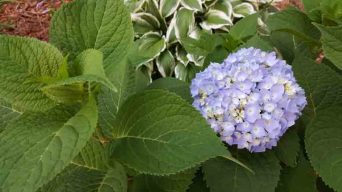Hydrangeas need 4-6 hours of direct sunlight, prefer the morning sun, and partial shade in the afternoon. Some species can tolerate more sun. Oakleaf, climbing, and mophead varieties can handle 3-6 hours of direct sun. Panicle Hydrangea can tolerate more sun. Hydrangeas can also grow in full shade.
Gardeners and plant enthusiasts belove hydrangeas for their vibrant colors, lush foliage, and magnificent blooms.
But just like other plants, these beauties have specific sunlight requirements to grow healthy and produce those awe-inspiring flowers.
In this guide on hydrangea sunlight needs, we will dive deep into understanding the factors that affect how much sun your hydrangea requires and explore ways to ensure optimal growth.
Understanding Hydrangeas’ Sunlight Needs
The hydrangea, a beloved garden staple, is a versatile plant with unique sunlight preferences.
Different hydrangea species have distinctive needs when basking in the sun’s rays, from the shade-tolerant to the sun-seekers.
Understanding these differences is essential for a flourishing garden.
Different Species And Their Sunlight Needs
Understanding different hydrangea species’ sunlight requirements is essential for optimum growing conditions.
The table below will help you get acquainted with the specific sunlight needs of various hydrangea varieties, so you can make informed decisions about planting and caring for your hydrangeas.
| Hydrangea Species | Optimal Sunlight Exposure |
|---|---|
| Bigleaf Hydrangea (Hydrangea macrophylla) | Partial shade (3-6 hours of direct sunlight) |
| Smooth Hydrangea (Hydrangea arborescens) | Partial shade (3-6 hours of direct sunlight) |
| Panicle Hydrangea (Hydrangea paniculata) | Full sun (at least 6 hours of direct sunlight) |
| Oakleaf Hydrangea (Hydrangea quercifolia) | Partial shade (3-6 hours of direct sunlight) |
| Climbing Hydrangea (Hydrangea anomala subsp. petiolaris) | Partial shade to full shade (less than 3 hours of direct sunlight) |
| Mountain Hydrangea (Hydrangea serrata) | Partial shade (3-6 hours of direct sunlight) |
Remember that your planting location, climate, and soil conditions may influence these sunlight requirements.
Balancing these factors with the sunlight exposure requirements of your specific hydrangea species will help ensure optimal growth and bloom potential for your plants.
Shade Varieties
Shade-tolerant hydrangeas thrive in partial shade, such as the bigleaf hydrangea (Hydrangea macrophylla) and mountain hydrangea (Hydrangea serrata), with about four hours of sunlight per day.
In cooler climates or woodland settings where dappled sunlight filters through nearby trees, Lacecap Hydrangeas can be an excellent addition to your garden.
These hardy shrubs bring color and interest to shaded areas and are remarkably resilient against pests and disease.
However, monitoring their growth patterns for signs of stress due to insufficient light exposure is crucial – this might manifest as sparse flowering or poor leaf development.
Sun Varieties
Sun-loving varieties of hydrangeas are perfect for gardeners who want to fill their outdoor spaces with vibrant colors and breathtaking blooms.
One striking example of a sun-tolerant hydrangea is the Panicle Hydrangea, which can withstand full sun exposure while thriving in partial shade.
Another excellent option for sun-drenched gardens is the Oakleaf Hydrangea.
This cold-hardy plant boasts impressive flowers and delights with its eye-catching foliage throughout the year.
Thanks to its adaptability, Oakleaf Hydrangea can grace your landscape, whether planted under direct sunlight or tucked into shadier corners.
Negative Effects Of Too Much Or Too Little Sunlight
Hydrangeas can be sensitive to too much or too little sunlight.
When exposed to excessive sunlight, hydrangeas can experience burnt leaves and flower buds that droop and fail to bloom properly.
In extreme cases, the leaves may turn yellow and fall off entirely.
On the other hand, insufficient light can also negatively affect hydrangeas.
Too little light can result in plants with weak stems that are prone to breakage, as well as fewer blossoms overall.
Finding a balance between insufficient or too much sun exposure will ensure your hydrangea stays healthy and vibrant throughout the growing season.
Finding The Ideal Sun Exposure For Your Hydrangeas
As you stand amidst the vibrant blooms of your hydrangeas, you can’t help but wonder if they’re getting the right amount of sun.
A delicate balance of factors, from your planting location to the local climate, determines the ideal level of sun exposure.
To find it, you must observe your plant’s response to light and consider implementing strategic shade structures.
Analyzing Your Planting Location And Climate
When considering the ideal sun exposure for your hydrangeas, it’s crucial to analyze your planting location and climate.
Here are some factors to keep in mind:
- Hardiness zones: Hydrangeas have different sunlight requirements based on their hardiness zones. Be sure to research which varieties grow best in your specific zone.
- Soil type and pH: Hydrangeas prefer moist, well-drained soil with a pH range of 5.2 to 6.0 for blue flowers and 6.0 to 6.2 for pink or red flowers.
- Sun exposure: Consider how much direct sunlight your planting area gets throughout the day and any nearby trees or buildings that may provide shade.
- Climate: Hydrangeas thrive in moderate temperatures and struggle in extreme heat or cold conditions. Be sure to choose varieties that are suitable for your environment.
- Water availability: While hydrangeas need frequent watering, they can also suffer from overwatering or drought stress. Make sure you have a plan in place for consistent watering.
By taking these factors into account, you’ll be able to find the perfect spot for your hydrangea shrubs and ensure they get the right amount of sunlight for optimal growth and blooming season success!
Observing The Plant’s Response To Sunlight
Observing its response is one of the best ways to determine if your hydrangea is getting the right amount of sunlight.
Most species of hydrangeas will show signs of stress if they are not receiving enough or too much sun exposure.
For instance, if your hydrangea leaves start turning yellow or have brown spots, there’s a good chance that it’s getting too much sunlight.
Another way to observe your hydrangea’s response to sunlight is by examining its branches.
If you see that most of the branches are stretching toward one side where the sun hits directly, then this means that your plant may be reaching out for more light exposure.
Implementing Shade Structures
If your hydrangeas require partial shade or you live in an area with intense sunlight, implementing shade structures can be a great solution to provide optimal sun exposure for your plants.
Here are some options to consider:
- Garden Umbrella: A garden umbrella provides a convenient way to create shade over your hydrangeas. The umbrella is easily set up and adjustable; hence you can position it for maximum shade coverage.
- Shade Cloth: A shade cloth is another option for creating an excellent microclimate around your plants. It comes in different shapes and sizes, making it possible to customize it according to the desired coverage size.
- Tree Canopy: If a nearby tree is around your hydrangea planting location, take advantage of it by positioning the plant under its canopy. Trees help filter out harsh sunlight and provide enough shade that most hydrangeas require.
- Trellis: If you have climbing hydrangea varieties, train them on trellis structures as they mature. This will allow for more control of where the sun hits your plant while providing ample light.
- Patio Cover: If your planting location is next to a patio or porch, adding a patio cover will give optimal shading during peak sunlight hours.
Optimizing Sun Exposure For Your Hydrangeas
As the gentle breeze carries the sweet scent of blooming flowers, every gardener knows the importance of sunlight exposure for their beloved flora.
Among them, hydrangeas stand out with their vibrant and strikingly diverse colors.
But how can one optimize sun exposure to keep their hydrangeas thriving?
Pruning For Controlled Sunlight Exposure
Pruning is an essential practice for controlling the sun exposure of your hydrangeas. Here’s how to prune for controlled sunlight exposure:
- Remove any dead, diseased, or damaged wood first. Cut back to healthy wood on the branch or main stem.
- Prune branches that are crossing and rubbing against each other to promote airflow and keep pests from hiding in the crevices.
- If you’re aiming for bigger flowers, prune back old growth by up to a third of the length in early spring before new growth appears. This will help rejuvenate your hydrangea bush and allow new flower buds to grow.
- Avoid pruning too late in the season, or you may accidentally remove next year’s flower buds. Prune any time after flowering up until late summer.
- Trim back any overly long branches using a clean pair of shears, following the shrub’s natural shape and cutting just above a bud facing outward from the center of the plant.
- For smaller hydrangea varieties like climbing hydrangeas or smooth hydrangeas, trim back all stems to within 10-15 cm from ground level in either late fall or early spring when they are dormant.
By pruning correctly, you can control sunlight exposure on your hydrangeas while promoting proper branching structure and bigger blooms next season!
Providing Proper Watering And Fertilization Techniques
Proper watering and fertilization are vital to keeping your hydrangeas healthy and blooming.
Here are some techniques to follow:
1. Watering
- Water at a rate of 1 inch per week throughout the growing season, as hydrangeas need consistent moisture.
- Water deeply and slowly rather than frequently and shallowly, especially during dry spells.
- Avoid getting water on the foliage, as it can encourage fungal problems.
- Consider using drip irrigation or soaker hoses to deliver water directly to the root zone.
2. Fertilization
- Use a slow-release fertilizer in early spring to encourage healthy growth and blooming.
- Too much fertilizer can result in leafy growth at the expense of blooms, so be careful not to over-fertilize.
- Rich soil may not require additional fertilization; adding vermicompost or other organic matter can provide sufficient nutrients for your hydrangeas.
- Check the soil pH, as hydrangeas prefer slightly acidic soil (between 5.2 and 6.0). If your soil is too alkaline, add sulfur or aluminum sulfate to lower the pH.
Following these proper watering and fertilization techniques will help your hydrangeas thrive and produce beautiful blooms year after year.
Mulching For Optimal Soil Moisture And Temperature Control
Mulching is one of the best ways to optimize sun exposure for your hydrangeas.
It helps retain soil moisture and regulate temperature, which is vital for the growth and health of your plants.
Here are some key points to keep in mind:
- Apply a layer of organic mulch around the base of your hydrangea bushes, being careful not to cover the stems or leaves.
- Some great mulch options include wood chips, bark, leaves, or compost. It’s essential to choose a type that will break down slowly over time so that it won’t rob nutrients from the soil.
- A 2-3 inch layer of mulch is ideal for optimal soil moisture control while also helping to regulate soil temperature.
- Mulching is especially beneficial during dry spells or extremely hot weather. It helps keep roots cool and moist, preventing stress on your hydrangeas.
- Additionally, mulching can help deter pests and diseases that thrive in warm, moist soil.
A regular mulching routine is an excellent way to ensure your hydrangeas receive optimal sunlight exposure while promoting healthy growth and blooming.
Final Thoughts
Choosing the right amount of sun exposure for your hydrangeas is crucial to their growth and beauty.
Different species have varying sunlight needs, so it’s essential to analyze your planting location and climate.
Watch for signs of overexposure or underexposure, such as yellowing leaves or fungal problems.
Prune branches for controlled sunlight to optimize sun exposure and provide proper watering techniques.
Mulching can help regulate soil moisture and temperature.
Remember that most hydrangeas only need morning sunlight, with some exceptions like the Paniculata variety.







